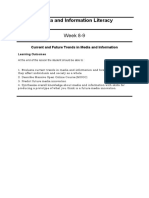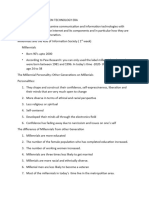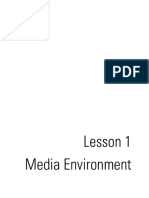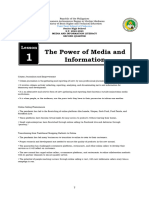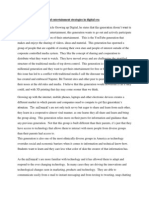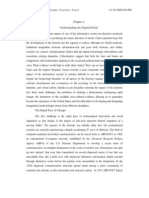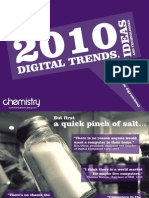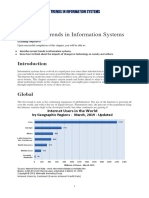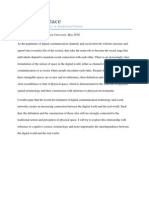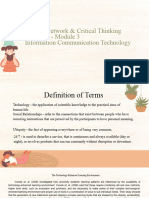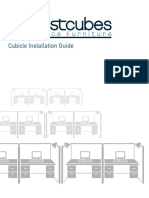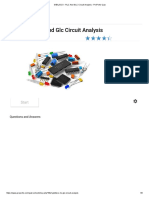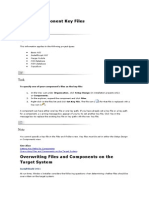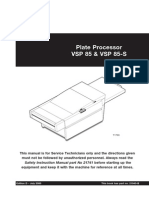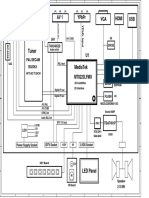!!
!
Evolving Better Filters
!
!!
!
!
Millenials were the first generation to grow up with internet in
the adaptation of hyper-discretion in millennials
The Internet Generation
the homefrom a young age. They very literally grew up with the
internet; that is, they grew up together, along side each other. As
the internet became more sophisticated, so did they, adapting to each
other as they both developed. As a result themillennials were (and
still are) the mostconnected generation in human history, which has
had a monumental effect on the way their brains think and process
information, on a fundamental level. Extreme connectedness to each
other and the technologies that enable that connection have provided
them with a uniquely global perspective as a generation. For
Millennials, nobody seems completely out of reach, in fact most people
on the planet are just a click and a few keystrokes away.
The internet has erased the real and imaginary borders that not
long ago were difficult or impossible to communicate across.
Millennials are the generation that best understands the truly global
nature of the internet and the power that comes with it. The explosion
of social media has given us the ability to share and consume data
instantaneously and indiscriminately in virtually all available media
types. The you are what you share mentality that is encouraged by
the plethora of social media sites and utilities that are popular
today, in combination with the development of fast and cheap mobile
web technologies that allow us to never have to be disconnected from
�the internet, has led to an incredible amount of data being generated
and shared chaotically every second of every day (4). With an ever
increasing amount of data being presented and/or made available to us,
the Millennials have learned how to most efficiently find what they
are searching for in the increasingly dense data cloud.
Internet paradigms are constantly shifting as web technologies
continue to advance. To analyze the ways in which Millennials use of
the internet today has effected their thought processes, we can look
to some statistical marketing data. 93.3% of the 86,2 million American
Millennials use the internet, the highest generational demographic by
far. Of those 80 million internet users, 65 million use Facebook and
almost 17 million have a Twitter account (3). Millennials have just
breached the threshold to become the largest demographic on Twitter,
and are sharing more now than ever before. The Millennials
relationship to the internet that developed throughout their youth is
strong. They developed an attitude of fearless adventurism toward the
cyber world. Confined to their bedrooms and home computers without
means to physically explore the world, most of us learned how to
effectively navigate and explore the possibilities of the ever
expansive web connecting us all. Common Millennial attitudes toward
the net can be defined by a few key characteristics that account for
the internets pervasive presence across the board in their generation:
!
1.
They arent afraid to try new tools: the tools referred to here are
not physical tools, like the computer itself, but digital tools
meant to provide the user with access to multiple functionalities
that effectively perform a task or service.
�Twitter,Facebook,Soundcloud, Youtube, Vimeo, Tumblr, Flickr,
Pinterest, Instagram, Yelp,Spotify, all of the Google products, and
the thousands of other popular websites and web-apps of the present
and future, are all designed to provide some service to the user
that is unique enough to rise above their competitors, while staying
true to the tropes that we have all become accustomed to, just
enough to make the service maximally usable as soon as possible
after subscribing. These service-tools are used by Millennials to
build fractured digital representations of their beings as
spatialized media collages of video, sound, text, and image,
existing across a multitude of digital platforms. The attempt by
Millennials to somehow perfect their digital image, that is
represent themselves in the way they see fit on and across the
internet, has led most to seek out multiple unique services to
express themselves in all the ways they find relevant (i.e. using
Instagram to create an image-narrative of my life for my followers,
using Soundcloud to showcase the music/sound/podcasts I make, using
Vimeo to host the videos I shoot, using Twitter to post every random
thought I have, etc.).
2. They are exceedingly adept at deciphering function from contextual
symbolism: Each of these web-based-service-tools has a proprietary
vocabulary that is used to reduce and compartmentalize
functionalities. One of the by-products of the use of multiple
service-tools is the development of a personal memory lexicon that
stores and associates the multiple web vocabularies one needs to
know in order to navigate the web and these effectively use these
service-tools to find, share, or display the content that we care
�about. These vocabularies include both text and symbol, with symbol
and image being used more often than ever to indicate available
functionality on (and off) the web. Developing these vocabularies
has given Millennials a huge bank of possible symbol-function
associations to use in an attempt to draw meaning from the data they
are confronted with.
3. They know how to search for the information they need, and have
evolved a heightened caliber of discretion they use to filter out the
spam that theydont need. Expanding on Hito Steyerls concept of
image spam as non-representative, non-essential images that are
meant to appeal to our neoliberal tendencies in the age of the everimperfect consumer, spam takes form in all media types (1). Spam can
be anything that is within the periphery of ones focus and nonessential to the task at hand. Whether swiping through spam emails,
or targeted sidebar advertisements based on datasets that analyze our
likes and dislikes, as Millennials are confronted with new data they
are establishing a threshold of relevance that is quick forming and
constantly shifting with their attention span and the task at hand
that most urgently demands their attention. Whatever falls within
their threshold is assigned some degree of importance and subsequently
delegated some amount of time or thought that seems appropriate;
everything that falls outside of ones relevance threshold is given no
attention and simply fades from their focus, freeing up mental space
for more association, analyzation, and relevance delegation. This
constant and seemingly instantaneous process can be described as a
form of Hyper-Discretion.!
�Hyper-Discretion and the Objectification of Data
We live in a time of planetary scale computation, where cloud
based computing and storage seem to have no physical manifestation
(when in fact they very much do). This idea that we have clouds of
data floating above us, available to everyone, and accessed
incessantly by machines and users of all types, has provided us with
the ability to use a seemingly endless amount of data to fit any need
imaginable. Benjamin Bratton illustrates the idea of planetary scale
computation elegantly with the Stack model,
Instead of seeing the various species of contemporary computational
technologies as so many different genres of machines, spinning out on
their own, we should instead see them as forming the body of an
accidental megastructure. Perhaps these parts align, layer by layer,
into something not unlike a vast (if also incomplete), pervasive (if
also irregular) software and hardwareStack. This model is of a Stack
that both does and does not exist as such: it is a machine that serves
as a schema, as much as it is a schema of machines. (2)
Existing within the Stack referenced above are all of the data
types humanity has invented thus far. With so much content available
at any given moment, from any given place on the planet, users have
had to develop procedures to deal with the sheer amount of data
presented to us from all angles, all the time. This has forced users
to think about data using a new mental model that categorizes data
efficiently so that we can quickly filter out data that we recognize
as non-essential.
To explain the process which the brain has naturally developed in
Millennials to use in dealing with massive amounts of incoming data, a
data-object model is useful. The objectification of data, in
simple terms, is a way of thinking about data that parallels the way
�we think about objects in the real world. We assign objects
characteristics based on function and physicality:
!
A hammer can be used to hammer nails, or remove nails that have been
hammered. A car drives and can be used to transport people and other
objects.
!
A digital video module can be used to showcase videos on the web.
Google can be used to search for information.
!
Data-objects exist on many levels. A high level data-object can
perform may functions, and therefore is characterized by the functions
it can perform, or the data it can present. A low level data-object
has limited functionality, for instance a search bar, an image, video,
or a block of text, and are characterized by their utility. High level
data-objects are comprised of multiple low level data-objects working
together to perform complex tasks that require a multitude of digital
interactions.
Objectifying data in this way allows us to quickly categorize all
incoming data by functionality using a learned vocabulary of
executable methods unique to all data-object types, which is essential
to Hyper-Discretion, or the enhanced ability to internally filter
extraneous data, without which finding relevant information would be
impossible. Hyper-Discretion can be described by a 3 step process:
scanning, knolling, and discerning.
!
!
�!
Scanning:
Taking in all available data and associating possible functionality to
each data-object. In the process of scanning the brain is attempting
to identify information and data-objects that are potentially useful
to the task at hand, tagging the useful information, and defocusing
as much extraneous data as possible within micro-second. Recognition
of recurring themes and tropes on the web is essential to the
instantaneous nature in which the brain relates function to dataobjects.
!
Knolling:
Knolling is a term American sculptor Tom Sachs adapted from Andrew
Kromelow, which he uses as the central idea for the mantra for his
studio. Knolling is a great visual summarization of the way that the
brain groups and organizes new incoming data. Sachs mantra Always Be
Knolling is described in the following series of steps (5):
!
1.
Scan your environment for materials, tools, books, music, etc.
which are not in use.!
!
2.
3.
4.
Put away everything not in use. If you aren't sure, leave
it out.!
Group all 'like' objects.!
Align or square all objects to either the surface they rest
on, or the studio itself.!
!
!Visualizing the brain as a work table with a finite amount of usable
space helps to illustrate the brains organizational process. As new
data is presented to and categorized by a user through the process of
�scanning, objects are then grouped and associated by likeness in
functionality. Seeing as the user is presumably navigating the
internet by making a series of decisions based on the need to perform
functions to complete tasks,
grouping data-objects by their possible
function is the most efficient way to isolate the most relevant data
within a given dataset.
!
Discerning:
The final step in the consecutive processes that are encapsulated
within Hyper-Discretion, is discerning, or recognizing the differences
between the set of data / data-objects that have been isolated and
identified as most useful through the knolling process. Discerning is
the process in which the brain exercises thoughtful discretion by
judging the usefulness of the remaining in-focus data to finally
come to a decision as to which data-object has the most utilitarian
value in relation to the present task at hand. This is the final
decision we make before interacting in some way with the chosen dataobject to initiate its function, or reap its information for our own
use.
!
To revisit and clarify theobjectification of data and symbol, the
idea can be described from two perspectives: first, Sachs mantra
"always beknolling" very accurately describes (in almost a literal
fashion, intentional or not) the process that the brain seems to
perform within micro-seconds of sensing new data: instantaneously
analyzing the presented information and searching through ones
language and symbol and function memory in an attempt to assign
�associations and relevance to objects, filtering out the irrelevant
objects from ones focus (just like putting away tools thatarent
needed to make space for the effective organization of the tools that
are necessary). The remaining potentially useful information is then
grouped by function and filtered further by relevance andclosenessto
the data, tool, function, link, image, or other data-object that is
being searching for. Second, it makes sense that the way brains
naturally adapted to constantly organize the relentless stream of new
information by function, mirrors the way that the expressed code is
written. "Object-oriented programming(OOP) is aprogramming
paradigmthat represents the concept of "objects" that havedata
fields(attributes that describe the object) and associated procedures
known asmethods (6). Its understandable why our brains organize
thesedata-objects by their sense-able attributes and the actions
they can perform, as these arethe most basic characteristics that all
digital objects have. Using these two views of thedata-object, as
objects that are constantlyknolledor sorted by likeness and filtered
by relevance, and in thinking about data-objectssuch as links,
images, and applications, as virtual objects that have attributes and
performable functions or methods, the term objectification is
justified in relation to the procedure the brain uses to sort and
define digital content, to help us filter down and focus on the most
relevant content available.
!
Attempting to describe these processes that occur on a time-scale that
applies to few occurrences outside of the brain or a computer, leads
to a long and wordy description of processes that are experienced so
�naturally that we arent usually conscious of them occurring at all.
The analyzation of incoming stimuli from data-objects happens without
our conscious consent. We cant help it. Hyper-Discernment will be
present in all generations following the Millennials as well, they
were just the only ones who got to mirror the development of the
internet from early infancy to adulthood, which makes them the perfect
population sample to investigate and identify the repercussions of the
introduction of such an incredibly new and powerful tool.!
!!
!
!
!
!
!
!
!
!
!
!
!
!
!
!
!
!
!
�Bibliography
!
(1)Steyerl, Hito. "The Spam of the Earth: A Withdrawal from
Representation." The Wretched of the Screen. Berlin: Sternberg,
2012. N. pag. Print.
!
(2) Bratton, Benjamin. "The Black Stack." E-flux. E-flux, 2014. Web.
22 Oct. 2014.
!
(3) eMarketer. "How Digital Behavior Differs Among Millennials, Gen
Xers and Boomers." Emarketer. Emarketer, 21 Mar. 2013. Web. 22 Oct.
2014.
!
(4) Wikibon. "A Comprehensive List of Big Data Statistics." Wikibon
Blog RSS. N.p., 1 Aug. 2012. Web. 22 Oct. 2014.
!
(5) Sachs, Tom. "10 Bullets, #8: "ALWAYS BE KNOLLING". By Tom
Sachs."YouTube. YouTube, n.d. Web. 22 Oct. 2014.
!
(6) "Object-oriented Programming." Wikipedia. Wikimedia Foundation, 21
Oct. 2014. Web. 21 Oct. 2014. (i knowbut really they had the best
description i could find)





